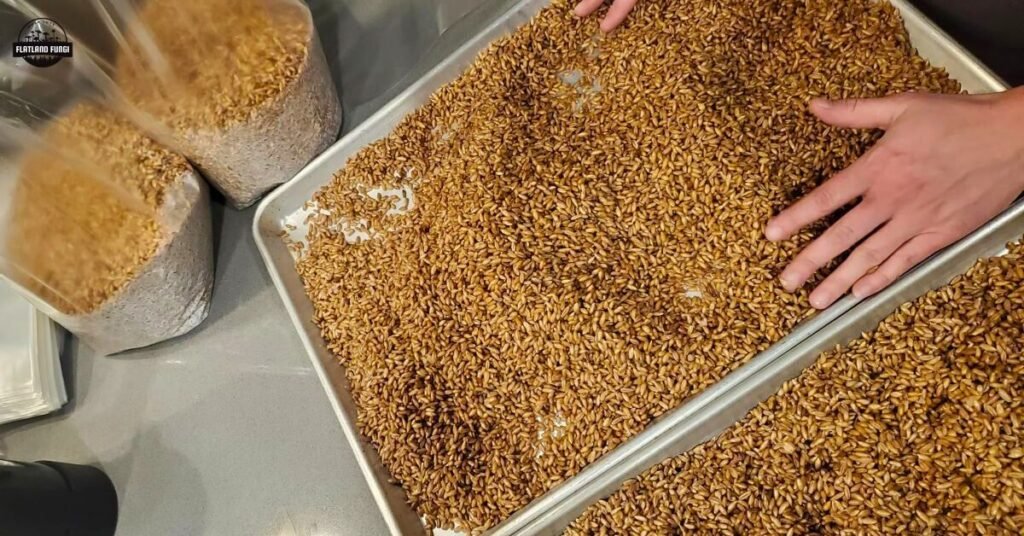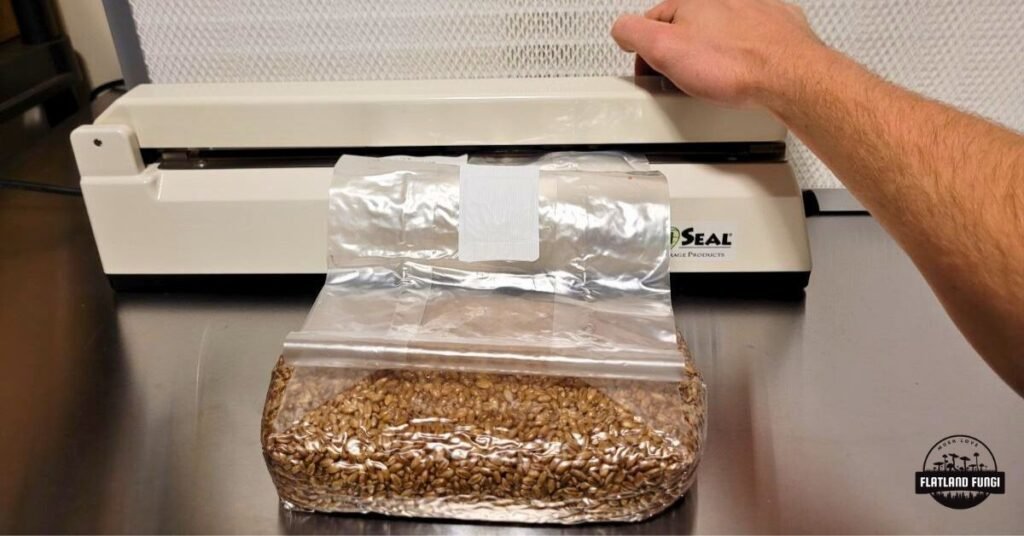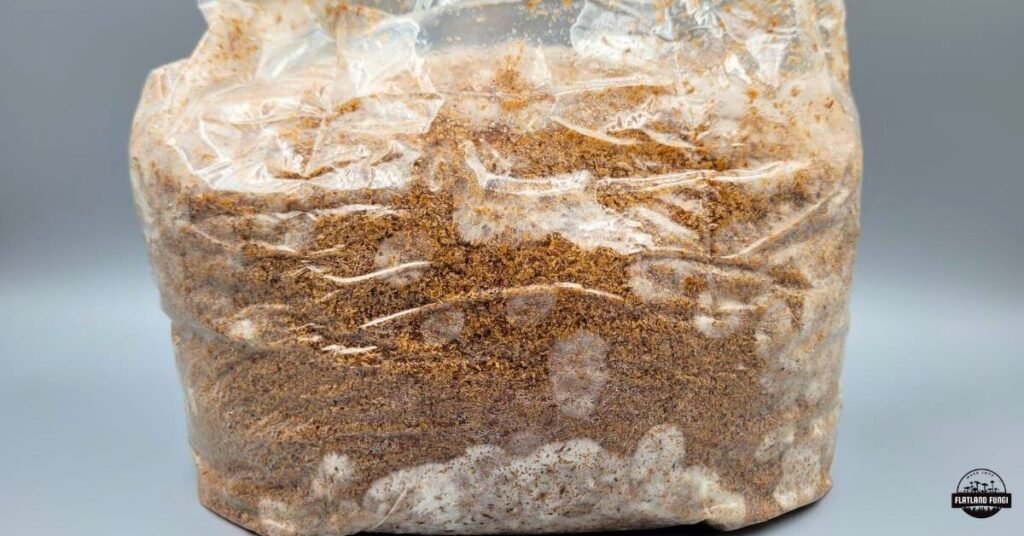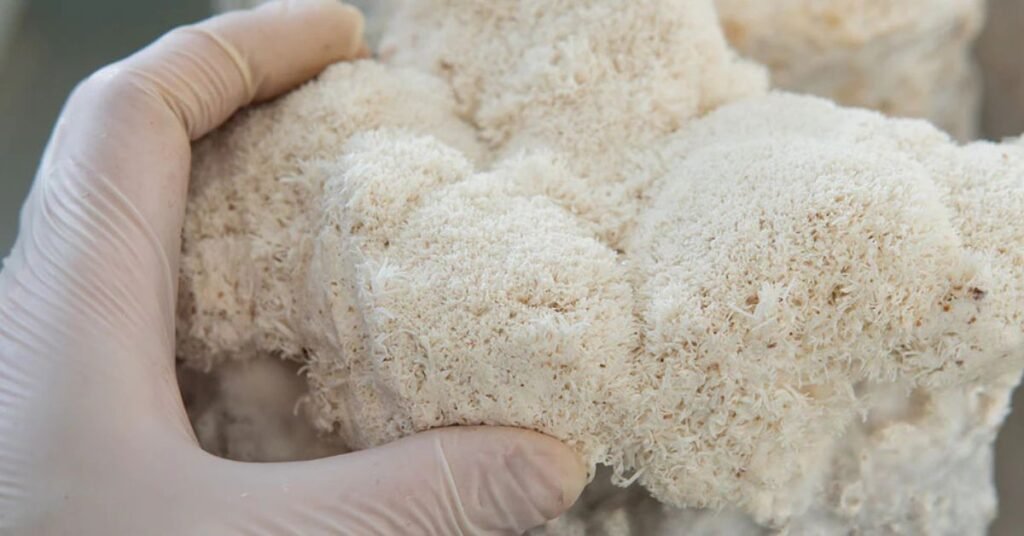
How to use Sterilized Coco Coir (CVG) Mushroom Substrate
In this guide, you will learn how to inoculate sterilized mushroom cvg substrate using colonized grain spawn. CVG substrate is

If I had to pick my favorite gourmet mushroom to grow, I’d have to say its the Lion’s Mane mushroom.
Why? Call me shallow but I think it’s one of the coolest most unique-looking mushrooms out there.
Aside from their snowball appearance, Lion’s Mane is quite easy to grow, boasts an impressive list of health benefits, and tastes great, actually a bit like steak.
You might not find Lion’s Mane in your local supermarket, which means growing them at home is essential if you want a steady supply of fresh mushrooms.
Fortunately, in this guide, I’ll show you how to grow your own Lion’s Mane at home step by step. First, let’s explore what makes Lion’s Mane mushrooms truly exceptional.
The Lion’s mane mushroom, also known by its scientific name Hericium Erinaceus is distinguished by its large, white, and fluffy appearance, resembling a pom-pom.
The “teeth” or “needles” of the mushroom droop downwards during fruiting, contributing to its shaggy, lion’s mane-like appearance.
This mushroom is found in Asia, Europe, and North America, thriving on decaying hardwood in the forests of the northern hemisphere.
Lion’s mane mushrooms feature a soft, spongy texture and a structure akin to cauliflower, with branches emerging from a central base.
They offer a mild sweet taste, often compared to crab or lobster, which makes them a sought-after ingredient for a meaty texture in vegetarian recipes.
Beyond their culinary use, lion’s mane mushrooms are prized for their medicinal properties, offering a variety of potential health benefits.

Here are some of the most notable health benefits of Lion’s Mane:
| Natural Habitat: | Dead & decaying hardwood throughout North America |
| Cultivation Difficulty: | Easy to Medium |
| Favorite Spawn: | Rye grain spawn |
| Favorite Substrate: | Supplemented hardwood, Masters Mix |
| Fruiting Containers: | Autoclavable filter patch 14A fruiting bags (not spawn bags) |
| Preferred Temperature: | Spawning 20 – 25 C, Pinning 15 C, Fruiting 15 – 20 C |
| Expected Yield: | 2 lbs or more from a 5 lb fruiting block |
| Species Specifics: | It is sometimes hard to achieve full spawn colonization with Lion’s Mane mycelium & it bruises easily during fruiting, do not mist its fruits directly or they may brown. |
Let’s learn how to cultivate Lion’s Mane from start to finish. There are several methods to grow Lion’s Mane mushrooms indoors at home, I will show you the easiest and fastest method.
If growing your own mushrooms seems too complicated and time-consuming, we recommend purchasing colonized Lion’s Mane spawn or a grow kit from a reputable supplier. Buying colonized spawn or a grow kit can drastically reduce the time it will take for you to harvest your first Lion’s Mane mushrooms and reduce the margin for error.
But, if you’re like me and enjoy doing everything yourself, then keep reading!

Supplies
Keeping your workspace, spawns, substrate, and cultures clean and sterile is essential to successful mushroom cultivation. Each step of the process takes a significant amount of time, and the last thing you want is for you to introduce competing bacteria to your developing mycelium, resulting in a contaminated grow.
Take the time to clean all of your tools, yourself, workspace, and supplies with isopropyl alcohol, as well as ensure spawns and substrates are sterilized correctly.
If you don’t have an autoclave sterilizer, we offer pre-sterilized spawn and substrate for your convenience.

Now let’s talk workspaces.
Choose a space that has limited airflow and one where you can close off the area such as a small spare bedroom or bathroom. Turn off any airflow in the room (fans, AC, heater, etc.), and inform anyone you live with to avoid entering the room while you are working.
Limiting airflow within your workspace will reduce the amount of potentially harmful particles floating in the air.
If mycology is going to be a permanent hobby, then I highly recommend investing in a laminar flow hood or a still air box to do your clean work within. These tools can greatly reduce the amount of contamination within the mushroom growing cycle.
Flow hoods can get quite pricey, ranging from $500 to $2000. Building your own still air box is much more feasible for most hobbyists and they’re quite effective. Still air boxes are cheap, effective, and easy to make. You can build one yourself for around $50.

Check out this video guide to learn how to make one: How to Make and Use a Still Air Box
Lion’s Mane does particularly well on grain spawn, especially rye grain spawn.

Since mushrooms are 90% water and depend on it for their development, we need to hydrate our mushroom spawn.
The goal is to force as much water into the mushroom spawn without bursting it.
Soak your spawn for 12 to 24 hours in cold water.

Next, pour it into a pot and throw it on the stove. Simmer the spawn at medium to low heat for 30 minutes or until it’s visibly puffed and full of water, try to avoid bursting the grain.
A few burst gains aren’t a big deal, however, if too many have burst it’s best to start over again as they can cause contamination down the line.
Next is drying the grain. Pour the hydrated grain into a strainer removing any excess water. Then spread your spawn out on a flat surface using a towel to catch any remaining water.
Drying spawn typically takes 1 to 12 hours, the time required depends on the type of spawn, how much surface area you have, and the amount of spawn. Using a fan can reduce the drying time.
How dry should the spawn be? There should be limited visible moisture on the outside of the grains, while the inside should be packed full of water.

At this end of the hydration process, your spawn should be much heavier than when you started, spawns like rye can double in weight which is why Lion’s Mane loves it.
The next step is spawn sterilization.
Gather your hydrated grain and load it into autoclavable mushroom spawn bags at your desired weight increments.
Neatly fold the bags over themselves and load them into an autoclave/pressure sterilizer.

Sterilize for 2 hours at 15 PSI.
Allow the sterilized bags to cool for 12 to 24 hours.
Impulse seal the spawn bags to ensure no contaminants enter your freshly sterilized bags.

Next up is inoculating the sterile spawn with some form of Lion’s Mane genetics.
There are several types of genetics you can use to inoculate your mushroom spawn such as; colonized spawn, agar tissue, spores, or liquid culture.
We prefer to use Lion’s Mane liquid culture syringe, because of the liquid culture’s ease of use and fast colonization.
To inoculate your spawn bag, begin by cleaning the injection area, yourself, and your workspace. Then inject 5 ml to 10 ml of liquid culture through the bag and into the grain spawn.


Remove the syringe, and add a couple of layers of micropore tape to cover the hole (not necessary if you are using an injection port but still recommended).
Place your spawn bags in a dark warm place for the Lions Mane mycelium to colonize the spawn.
The ideal temperature for mycelium to colonize is 24 to 27 Celsius.
Temperatures below this range will still work but the growth will take longer. Avoid temperatures above 27 Celsius, as mold and contamination are prone to develop faster than the mycelium.
After the mycelium has colonized roughly 30 percent of the bag, mash and shake the spawn to disperse the mycelium throughout the bag, speeding up colonization.
Lion’s Mane takes between 2 and 6 weeks to fully colonize a healthy spawn.

Tip: Lion’s Mane is one of the more difficult species to achieve full spawn colonization. Its mycelium often appears faint and wispy making it seem like the spawn isn’t fully colonized, when it is. Break up the clumps of white mycelium often to encourage maximum colonization.
Although Lion’s Mane can grow in many types of substrate, it grows best in hardwood substrates. Either supplemented hardwood or the Master’s Mix are great choices.
You can find hardwood pellets at most hardware stores and supplements at animal feed stores. Or you can purchase our pre-sterilized and hydrated hardwood substrate if you feel like saving time and labor.

Its time to assemble, mix, hydrate, and sterilize your Lion’s Mane substrate.
Add the hardwood and desired supplements (we like wheat bran), into a bucket or large pot for mixing. Generally, the percentage of supplements to add is between 10 and 20%.
Add a liter of water at a time to your mixture to hydrate and expand the hardwood. Keep adding small amounts of water until you have reached field capacity.

Tip: For mushroom growing “field capacity” refers to the hydration levels of your mushroom substrate. When you hear “bring the substrate to field capacity” it means there should be only one or two drops of water flowing through your hand when you squeeze a handful of the substrate.
Now that your substrate is mixed and hydrated, its time to sterilize it.
Load the substrate into autoclavable 14A filter patch mushroom grow bags (different from mushroom spawn bags).
Supplemented hardwood substrate requires longer sterilization than some of the other types of substrates. Sterilize for 2.5 hours at 15 PSI.
Allow the autoclave and substrate to cool for 12 to 24 hours.
Impulse seal the substrate bags to ensure no contaminants enter your freshly sterilized bags.
To limit the risk of contamination, clean yourself, your tools, and your workspace thoroughly, and perform this next task in a still air box or in front of a flow hood.
The goal at this stage of the Lion’s Mane process is to mix your colonized spawn with the substrate to allow the mycelium to incubate (colonize) the fruiting substrate mixture.
First, break up the colonized spawn bag completely from the outside of the bag, this will make it easier to mix thoroughly with the substrate.
Cut the seal of both spawn and substrate bags, pour the spawn into the substrate bag, then seal it with an impulse sealer or zip tie it quickly to avoid unwanted bacteria from entering your sterile medium.


Mix and mash the spawn and substrate together from outside the bag until you’re satisfied it’s mixed thouorghly.
Allow the colonized spawn to incubate (colonize) the fresh substrate mixture, this step is similar to spawn colonization. Place the newly created substrate in a dark warm place for optimal colonization.

It takes roughly 7 to 14 days for Lion’s Mane to colonize the substrate. Once full colonization is achieved, it’s time for the fun part; fruiting!
Mushrooms need two things to fruit (grow); humidity and fresh air exchange. They also benefit from a small amount of light but lighting isn’t nearly as important as increasing the humidity and fresh air.
Fruit by cutting small x’s where primordia are developing, or where the mycelium naturally starts to fruit. Avoid cutting the top off the bag or cutting too many x’s as this can dry out the substrate quickly.

Now that the x’s are cut, fresh air is increased for fruiting but what about humidity?
Humidity can be increased in various ways depending on your setup.
The most basic method is to mist the fruiting block with a fine mist water spray bottle until you see primordia form. Once the Lion’s Mane mushroom begins to form avoid misting it directly as it can cause browning of the fruiting body.
Another DIY option to ensure humidity is to build a makeshift humidity tent, this can be done by placing saran wrap or a Ziploc bag over the fruiting block. The “humidity tent should be supported by something that ensures there is lots of space between the fruiting block and tent allowing for enough fresh air exchange. Mist the sides of the humidity tent to create an optimal fruiting environment.

If you wanted to go more high-tech, you could purchase a growing tent and install its own fogger, airflow, and light system. I won’t get into the details of this setup here though as this guide is intended for low-tech mushroom growing.
Let’s discuss lighting. Keep the Lion’s Mane fruiting block out of direct sunlight. Indirect sunlight and everyday household light are enough for your mushrooms to thrive. Operate the light as you normally would, on when you are awake and at home, and off when you’re asleep.
Harvest the Lion’s Mane by cutting it from its stem near to where the mushroom meets the fruiting block.

Harvest delicately to avoid damaging the beautiful mushroom spines and to prolong its life after harvest.
Place the Lion’s Mane fruiting block back in fruiting conditions and more mushrooms will eventually grow from the x’s you cut earlier.

Avoid cutting more x’s this will dry the block out further. When the mycelium has run out of nutrients it will no longer produce fruits. You’re inputs and growing conditions will determine the size and amount of fruits produced.
Q: How long does it take to grow lion’s mane mushrooms?
A: Lion’s Mane mushrooms take 6 to 8 weeks from inoculation to harvest.
Q: Can you grow Lion’s Mane in Canada?
A: Canada is one of the best places to grow Lion’s Mane mushrooms due to our temperate climate and mild temperatures.
Q: Can I grow Lion’s Mane at home?
A: The easiest way to grow Lion’s Mane mushrooms at home is by growing them in a specialty mushroom grow bag. We offer all of the necessary supplies needed to cultivate at home and you can follow this guide to learn how to grow Lion’s Mane from start to finish.
Q: Where do Lion’s Mane mushrooms grow best?
A: Lion’s Mane mushrooms grow best in controlled indoor environments and produce the highest yields on sterile hardwood substrates.
Q: Is Lion’s Mane really good for you?
A: Studies have shown Lion’s Mane to have several health benefits such as: protecting against neurodegeneration, reducing symptoms of depression and anxiety, aiding in digestive health, strengthening the immune system, and reducing inflammation in the body.
Q: What is the best wood for Lion’s Mane?
A: For at-home indoor cultivation, Lion’s Mane thrives on hardwood pellets such as oak, maple, or beech due to their dense nutrient profile. These woods provide the mushroom with ample nutrients and hydration for healthy mycelium growth.
1. Kushairi, N., Phan, C. W., Sabaratnam, V., David, P., & Naidu, M. (2019). Lion’s mane mushroom, Hericium erinaceus (Bull.: Fr.) Pers. suppresses H2O2-induced oxidative damage and LPS-induced inflammation in HT22 hippocampal neurons and BV2 microglia. *Antioxidants*, *8*(8), 261. https://www.mdpi.com/2076-3921/8/8/261
2. Zhang, C., Yin, A., Li, H., Wang, R., Wu, G., Shen, J., … & Zhang, M. (2019). Dietary modulation of gut microbiota contributes to alleviation of both genetic and simple obesity in children. *Evidence-Based Complementary and Alternative Medicine, 2019*, 7861297. https://onlinelibrary.wiley.com/doi/10.1155/2019/7861297
3. Geng, P., Siu, K., Wang, Z., & Wu, J. Y. (2015). Antifatigue functions and mechanisms of edible and medicinal mushrooms. *Biomed Research International, 2015*, 418023. https://onlinelibrary.wiley.com/doi/10.1155/2015/418023
4. Ratto, D., Corana, F., Mannucci, B., Priori, E. C., Cobelli, F., Roda, E., … & Ferrari, B. (2017). Hericium erinaceus improves mood and sleep disorders in patients affected by overweight or obesity: Could circulating pro-BDNF and BDNF be potential biomarkers? *Evidence-based Complementary and Alternative Medicine, 2017*, 7861297. https://www.sciencedirect.com/science/article/abs/pii/S0378874115301306
5. Vigna, L., Morelli, F., Agnelli, G. M., Napolitano, F., Ratto, D., Occhinegro, A., … & Rossi, P. (2017). Hericium erinaceus reduces symptoms in mild cognitive impairment patients: A double-blind, randomized, placebo-controlled pilot clinical trial. *Frontiers in Immunology*, *8*, 666. https://www.frontiersin.org/journals/immunology/articles/10.3389/fimmu.2017.00666/full
6. Friedman, M. (2017). Chemistry, nutrition, and health-promoting properties of Hericium erinaceus (Lion’s Mane) mushroom fruiting bodies and mycelia and their bioactive compounds. *Journal of Agricultural and Food Chemistry*, *65*(32), 6999-7008. https://pubs.rsc.org/en/content/articlelanding/2017/fo/c7fo00071e

In this guide, you will learn how to inoculate sterilized mushroom cvg substrate using colonized grain spawn. CVG substrate is

In this guide, you will learn how to inoculate sterilized mushroom grain spawn using a liquid culture syringe, spore syringe, colonized spawn, or agar culture.